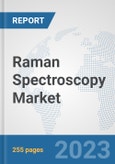Raman spectroscopy is a non-destructive analytical technique that provides comprehensive information about the chemical composition, structural characteristics, phase variations, crystallinity, and molecular interactions of a substance. It relies on the interaction of light with chemical bonds within a material. The market growth of Raman spectroscopy is anticipated to be driven by the rising demand from the pharmaceutical and biotechnology sectors. These industries are experiencing continuous expansion and actively developing new drugs and therapies. Consequently, there is a growing need for advanced analytical tools, such as Raman spectroscopy, which can offer rapid, precise, and non-destructive sample analysis. Moreover, the application of Raman spectroscopy in material science is expanding, further fueling the market's growth.
Benchtop is the fastest-growing segment in the Type of the Raman Spectroscopy Market
Benchtop Raman spectroscopy refers to a type of Raman spectroscopy system that is designed to be used on a laboratory bench or workbench. It is a compact and portable instrument that offers Raman spectroscopic capabilities for various analytical applications. A benchtop Raman spectroscopy system typically consists of a laser, a spectrometer, and a detector. The laser emits a monochromatic light beam that interacts with the sample under investigation. The scattered light from the sample is collected and sent to the spectrometer, which separates the scattered light into its different wavelengths. The detector then measures the intensity of each wavelength, generating a Raman spectrum.North America region holds a significant share of the Raman Spectroscopy Market
The Raman spectroscopy market in North America is projected to exhibit dominance owing to the presence of well-established companies and significant investments in Research and Development activities. The United States, in particular, is expected to make a substantial contribution to the regional market growth due to the expanding utilization of Raman spectroscopy in various applications such as drug discovery and material science. Additionally, the increasing demand for Raman spectroscopy across multiple industries, including pharmaceuticals, biotechnology, and food & beverages, is driving the market growth in the North America region.Report Findings
1) Drivers
- Increasing demand from pharmaceuticals and biotechnology industries expected to drive the market growth.
- Growing applications in material sciences expected to boost the market growth
2) Restraints
- Lack of awareness and technical expertise expected to hamper the market growth
3) Opportunities
- Integration with other technologies expected to create lucrative growth opportunities for the market growth.
Research Methodology
A) Primary Research
The primary research involves extensive interviews and analysis of the opinions provided by the primary respondents. The primary research starts with identifying and approaching the primary respondents, the primary respondents are approached include- 1. Key Opinion Leaders associated with the publisher
- 2. Internal and External subject matter experts
- 3. Professionals and participants from the industry
The primary research respondents typically include
- 1. Executives working with leading companies in the market under review
- 2. Product/brand/marketing managers
- 3. CXO level executives
- 4. Regional/zonal/country managers
- 5. Vice President level executives
B) Secondary Research
Secondary research involves extensive exploring through the secondary sources of information available in both the public domain and paid sources. Each research study is based on over 500 hours of secondary research accompanied by primary research. The information obtained through the secondary sources is validated through the crosscheck on various data sources.The secondary sources of the data typically include
- 1. Company reports and publications
- 2. Government/institutional publications
- 3. Trade and associations journals
- 4. Databases such as WTO, OECD, World Bank, and among others.
- 5. Websites and publications by research agencies
Segments Covered
The global Raman spectroscopy market is segmented on the basis of type, sampling technique, and application.The Global Raman Spectroscopy Market by Type
- Benchtop
- Portable
The Global Raman Spectroscopy Market by Sampling Technique
- Surface-enhanced Raman Scattering
- Tip Enhanced Raman Scattering
- Others
The Global Raman Spectroscopy Market by Application
- Pharmaceutics
- Research and Development
- Industrial Sector
- Material Science
- Others
Company Profiles
The companies covered in the report include
- Bruker
- Renishaw plc
- HORIBA Scientific
- Rigaku Corporation
- TSI
- Metrohm AG
- Ocean Insight
- Agilent Technologies, Inc.
- Shimadzu Corporation
- SciAps, Inc.
What does this Report Deliver?
1. Comprehensive analysis of the global as well as regional markets of the Raman spectroscopy market.2. Complete coverage of all the segments in the Raman spectroscopy market to analyze the trends, developments in the global market and forecast of market size up to 2030.
3. Comprehensive analysis of the companies operating in the global Raman spectroscopy market. The company profile includes analysis of product portfolio, revenue, SWOT analysis and latest developments of the company.
4. Growth Matrix presents an analysis of the product segments and geographies that market players should focus to invest, consolidate, expand and/or diversify.
Table of Contents
Companies Mentioned
- Bruker
- Renishaw plc
- HORIBA Scientific
- Rigaku Corporation
- TSI
- Metrohm AG
- Ocean Insight
- Agilent Technologies, Inc.
- Shimadzu Corporation
- SciAps, Inc.
Table Information
| Report Attribute | Details |
|---|---|
| No. of Pages | 255 |
| Published | May 2023 |
| Forecast Period | 2022 - 2030 |
| Estimated Market Value ( USD | $ 786.85 Million |
| Forecasted Market Value ( USD | $ 1497.85 Million |
| Compound Annual Growth Rate | 7.3% |
| Regions Covered | Global |
| No. of Companies Mentioned | 10 |









